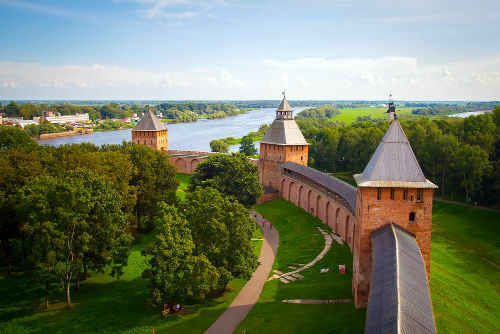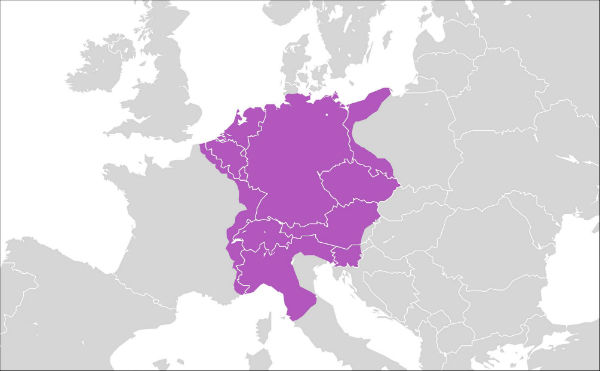Throughout its history, the Russia it was ruled by several emperors – most of them linked to two dynasties: Rurik and Romanov. The intention of this text is to highlight some events from the period of the Rurik dynasty, which existed between the 9th and 16th centuries.
russian dynasties
As mentioned, Russian political history is marked by the existence of two great dynasties that ruled the country over the centuries. The Rurik dynasty began when the prince Rurik he was invited by the lords of Novgorod to assume the throne of his city in 862. Rurik's accession to the throne of Novgorod and the succession of his heirs started the RusKievan.
The Kievan Rus was a state that emerged from the conquest of territories and the union of Slavic tribes and Finnish under Kiev (Rurik's successors transferred the throne from Novgorod to Kiev). It was also during this period that Orthodox Catholicism gained strength in this region corresponding to today's Russia.
The Rurik dynasty remained hegemonic in the region when the Kievan Rus fell into decay. They occupied the throne of the ascendant Grand Duchy of Moscow. The kings of the Rurik dynasty occupied the Muscovite throne until the end of the 16th century, and the end of this dynasty occurred from 1598, when Tsar Theodorus I died and the beginning of the
Time of difficulties.The Time of Trouble was a troubled period in Russian history, marked by famine, wars, widespread violence and dynastic disputes. Russia was invaded by foreign troops from Poland and Sweden while the throne was being disputed. The dispute for the throne happened because there were no direct heirs to the throne of the Rurik dynasty.
The end of this period is considered when Mikhail Fiodorovitch Romanov was chosen and elected by the boyars (Russian nobles) to occupy the Muscovite throne. The ascension of Mikhail (or Miguel, in Portuguese) to the throne took place in 1613 and, with him, began the Romanov dynasty, which ruled Russia until 1917, when the then last emperor, Nicholas II, was stripped of the throne during the unfolding of the Russian revolution.
During the Romanov dynasty, the power of the Russian Empire was consolidated and centralized. New regions were conquered and integrated into the empire ruled from Moscow. Starting in the 18th century, the Romanovs transferred the seat of government to Saint Petersburg and there they remained until the fall of the dynasty.
Establishment of Rurik and the Kievan Rus

Towers of the Novgorod Kremlin, city where Rurik became king in 862
The prototype of what would one day become the Russian state was born in the ninth century, in the lands between the Dnieper and Volga rivers. At that time, the entire region was inhabited by several tribes of Slavic and Finnish peoples, who they survived from fishing, hunting and gathering, as well as from agriculture and trade in the surplus goods that were produced.
The wealth of the trades established in that region (in addition to goods from the surrounding area, the markets in that locality had goods from the East) attracted explorers vikings, mostly Swedes, looking for easy wealth. These Viking explorers, known as Varangians, gained strength and influence over local populations.
One of these Varangians was Rurik, a Swedish prince who was invited by the nobles of Novgorod and from the surroundings to occupy the throne of his city from 862. According to Janet Martin, the lords of Novgorod invited Rurik to take over the city because believed that he could bring security, thus ensuring the peace and prosperity of Novgorod|1|.
Rurik ruled until 879 or 882 (date varies by source), and his successors continued his legacy. His successor was Oleg, who transferred the capital to Kiev and was responsible for conquering countless territories. During his government, the Kievan State, known as Kievan Rus.
From there, the Kievan State grew and prospered as recorded below:
According to the Chronicle, the number of tribes subject to the Ruriks has increased, including the Kriviches (in the region of the the Valdai hills), the Polians (near Kiev on the Dnieper River) and the Drevlians south of the Pripiat river, a tributary of the Dnieper). In addition, the Ruriks had taken control of the Dnieper, an important commercial artery. From Kiev's strategic position, they could control all traffic moving to the Black Sea, to the Byzantine colony of Kherson, and to the sea route to the River Don and the Khazar Empire. Oleg, in 907, and Igor, in 944, with less success carried out military campaigns against Constantinople, which resulted in treaties that allowed Rus to negotiate not only in Kherson, but also in the rich markets of Constantinople itself, where they contacted merchants and had access to goods from virtually all over the world. known|2|**.
Do not stop now... There's more after the advertising ;)
As the Kievan Rus grew and prospered, a whole structure of government bureaucracy emerged that supported all administrative matters. The kings started to divide the Kievan territory, and its administration was given to different princes of the line of succession of the Rurik dynasty.
THE Rurik dynasty played an essential role in the consolidation of Orthodox Christianity as the hegemonic religion of Russia. Christianity was made an official religion during the reign of Vladimir (980-1015). Vladimir had initially adopted pagan religious practices that had characteristics inherited from Nordic, Slavic, and Finn (Finnish) religiosity.
However, during his reign, Vladimir left these religious practices and adopted Christianity as a religion. He abandoned his many wives and married the emperor's sister Byzantine Basil. An Orthodox see was established in Kiev and clergymen were sent throughout the Kievan domain to preach Orthodox Christianity.
The enrichment of Rus combined with the strengthening of Orthodox Christianity in that kingdom made different churches were built over time: Church of the Transfiguration of Our Savior, in 1035; Church of the Mother of God, between 1136-1137, and the Dormition Cathedral in 1158. These different churches were built respectively in the cities of Chernigov, Smolensk and Vladimir|3|.
The weakening of the Kievan State took place from the 12th century onwards, mainly due to a series of dynastic disputes that provoked several civil wars. Succession to the throne in Kiev happened sideways, and the heir would be the eldest relative of the older generation of the Rurik dynasty. So, there was a lot of confusion and dispute for the throne. This, in the long run, weakened Kiev.
A foreign invasion followed the weakening of Kiev: the Mongols. Between 1237 and 1240, Batu Khan, grandson of the great Genghis Khan, conquered the territories belonging to Rus and imposed a khanate (empire), forcing the Kievan Russians to pay tribute to him. The Mongols dominated this region corresponding to Russia until 1480 and were only expelled by action of the Grand Duchy of Moscow.
A noticeable change that took place during this period was the transfer of the power center from Kiev to Moscow, which was ruled by members of the Rurik dynasty until the end of the 16th century. This change was gradual and happened as the city of Moscow enriched itself and increased its influence over the surrounding regions.
End of the Rurik dynasty
The Rurik dynasty is considered to have come to an end when, in 1598, Theodore I he died, leaving the Russian throne without rulers, as there were no longer any Rurik successors alive. This ushered in a period of Russian history known as Time of difficulties, as already mentioned.
Theodore I's last heir had been Demetrium, younger son of Ivan IV, killed in 1591 under unclear circumstances. The lack of heirs caused two imposters to emerge, claiming to be the Demetrius who had died in 1591.
You false Demetrius they were supported by different Russian nobles and allied with foreign forces (Polish and Swedes). This resulted in the invasion of Russian territory by both Polish and Swedish troops. Territory was lost to both nations, and Moscow's power was briefly occupied by Polish forces.
So many wars have added to the economic difficulties that already existed in Russia because of bad administrations by previous czars. This resulted in the weakening of Muscovite power, but it also spread famine throughout the interior of Russian territory. The dynastic question was resolved in 1613, when Mikhail Fiodorovitch Romanov (Michael I) was chosen to be the new tsar.
The peace with the Swedish and Polish invaders was only resolved from agreements made throughout the 1610s, however, the Russians were forced to cede a series of territories to both. From that moment on, the Romanov dynasty began (they were in power in Russia until 1917).
|1| MARTIN, Janet. From Kiev to Muscovy. In.: FREEZE, Gregory L. (org.). Russian history. Lisbon: Editions 70, 2017, p. 37.
|2| Idem, p. 37.
|3| Idem, p. 41.
*Image credits: ppl and Shutterstock
**The excerpt quoted was taken from a book translated into Portuguese from Portugal, so it follows with original typical words and expressions.
By Daniel Neves
Graduated in History



